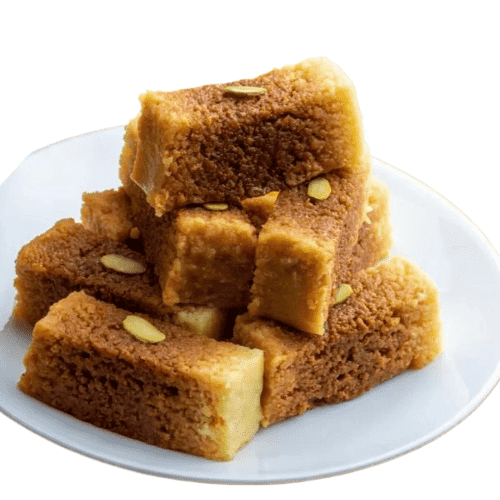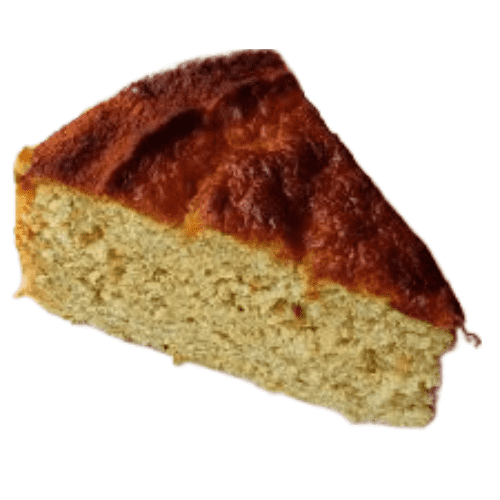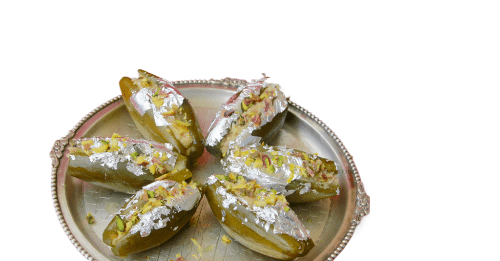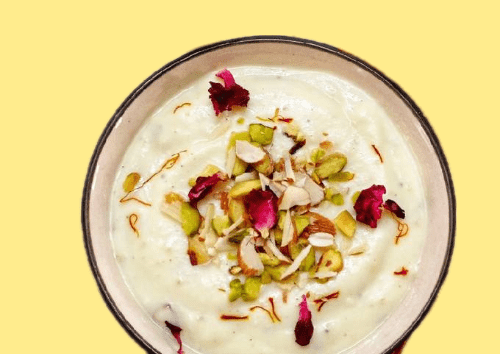Moong Dal Ka Halwa
Introduction Of Moong Dal Ka Halwa :
Moong Dal Ka Halwa is an iconic Indian dessert, revered for its rich, indulgent flavor and melt-in-the-mouth texture. Originating from the northern regions of India, this delightful sweet is often prepared during festivals, weddings, and special occasions. The main ingredient, moong dal (split yellow gram), is cooked with ghee, sugar, and milk, resulting in a luscious and fragrant dessert. In this comprehensive guide, we’ll explore the history, preparation, and tips for making the perfect Moong Dal Ka Halwa.
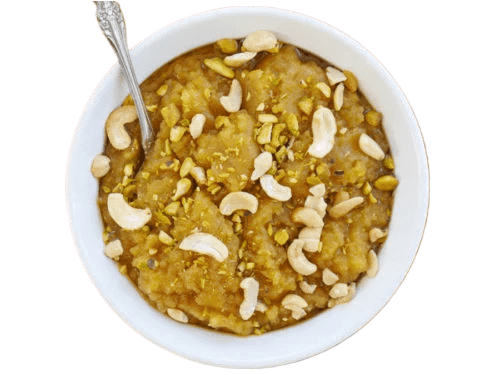
History and Cultural Significance Of Moong Dal Ka Halwa:
Moong Dal Ka Halwa has its roots in the royal kitchens of Rajasthan, a state known for its rich culinary heritage. Traditionally, this halwa is made during winter months, as it is believed to provide warmth and energy. The generous use of ghee, dry fruits, and khoya (mawa) makes it a rich and nourishing dessert, perfect for cold weather. Over time, it has become a staple in festive celebrations like Diwali, Holi, and various religious ceremonies.
Ingredients: The Building Blocks of Flavor :
Understanding the ingredients is crucial for mastering Moong Dal Ka Halwa. Here’s a point by point see at each component and its part in the formula:
- Moong Dal (Yellow Split Gram): The star of the dish, moong dal, is known for its high protein content and earthy flavor. It needs to be soaked and ground to a coarse paste, which forms the base of the halwa.
- Ghee (Clarified Butter): Essential for roasting the dal and giving the halwa its signature richness and aroma. Ghee also prevents the dal from sticking to the pan and burning.
- Milk: Adds creaminess and helps cook the dal to a soft, luscious consistency. Full-fat milk is recommended for the best results.
- Sugar: Sweetens the halwa and balances the flavors. The quantity can be adjusted according to taste.
- Khoya (Mawa) or Condensed Milk: Optional but recommended for an extra rich and creamy texture.
- Cardamom Powder: Adds a warm, aromatic note that enhances the overall flavor of the halwa.
- Dry Fruits and Nuts: Almonds, cashews, pistachios, and raisins add crunch and a burst of flavor. They are also a source of added nutrition.
- Saffron: Soaked in warm milk, saffron imparts a beautiful golden color and a unique floral aroma.
Preparation Of Moong Dal Ka Halwa :
Let’s delve into the detailed process of making Moong Dal Ka Halwa, ensuring every step is covered for a flawless result.
Soaking and Grinding the Moong Dal:
- Washing: Start by thoroughly washing 1 cup of moong dal under running water to remove any dirt and impurities. Use a fine-mesh strainer for this purpose.
- Soaking: Place the washed dal in a large bowl and cover it with enough water. Soak for at least 4-5 hours or overnight. Soaking softens the dal, making it easier to grind and cook.
- Grinding: Drain the soaked dal and transfer it to a food processor or blender. Porus it to a coarse paste without adding water. The texture should be grainy, as this gives the halwa its characteristic texture.
Roasting the Dal:
- Heating Ghee: In a heavy-bottomed pan or kadhai, heat 1 cup of ghee over medium heat. The heavy bottom helps in even cooking and prevents the dal from burning.
- Adding Dal Paste: Once the ghee is hot, add the ground dal paste. Stir continuously to mix the dal with the ghee.
- Roasting: This step is crucial and requires patience. Roast the dal on low to medium heat, stirring constantly. The dal will gradually change color and release a nutty aroma. This process takes about 20-25 minutes. Proper roasting ensures that the raw taste of the dal is eliminated and enhances the flavor of the halwa.
Cooking with Milk:
- Boiling Milk and Water: In a separate pan, bring 1 cup of milk and 1 cup of water to a boil. The boiling liquid helps in cooking the dal evenly and prevents it from becoming lumpy.
- Combining: Carefully add the boiling milk-water mixture to the roasted dal. Be cautious as it may splutter. Stir continuously to combine the mixture and prevent lumps from forming.
- Simmering: Cook the mixture on low heat, stirring occasionally, until the dal absorbs all the liquid. This process takes about 10-15 minutes. The dal should become soft and mushy.
Adding Sugar:
Incorporating Sugar: Add 1 cup of sugar to the cooked dal mixture. Stir well to combine. The sugar will melt and make the mixture slightly liquidy again.
Cooking: Continue to cook on low heat, stirring frequently, until the halwa thickens and starts leaving the sides of the pan. This indicates that the halwa is reaching the right consistency.
Final Touches:
Adding Khoya: If using, crumble 1/4 cup of khoya and add it to the halwa. Alternatively, you can use condensed milk. Mix well until it blends completely into the halwa, enhancing its richness and creaminess.
Flavoring: Add 1/2 teaspoon of cardamom powder and mix well. Cardamom adds a delightful aroma and flavor to the halwa.
Dry Fruits and Nuts: Add 2 tablespoons each of chopped almonds, cashews, pistachios, and raisins. Stir to distribute them evenly throughout the halwa.
Saffron: Finally, add the soaked saffron along with the milk. Stir well to give the halwa a beautiful golden hue and a fragrant aroma.
Serving:
Once the halwa reaches the desired consistency, turn off the heat.
Serve hot, garnished with a few extra chopped nuts and a pinch of saffron strands for an elegant touch.
Tips for the Perfect Moong Dal Ka Halwa :
Achieving the perfect Moong Dal Ka Halwa requires attention to detail and patience. Here are some expert tips to ensure your halwa turns out flawless:
Roasting the Dal: This step is crucial for the flavor and texture of the halwa. Roast the dal on low to medium heat, stirring continuously, until it turns golden brown and releases a nutty aroma. Proper roasting ensures the dal is cooked evenly and the raw taste is eliminated.
Consistency: The halwa will thicken as it cools. If you plan to serve it later, you can leave it slightly liquidy during cooking. Reheat gently before serving to bring back the desired consistency.
Ghee: Generous use of ghee is essential for the rich taste and glossy texture of the halwa. Do not skimp on ghee, as it prevents the dal from sticking to the pan and enhances the flavor.
Milk: Full-fat milk adds creaminess to the halwa. If you want an even richer dessert, you can replace some of the milk with cream.
Sugar: Adjust the quantity of sugar according to your taste preference. If you prefer a less sweet dessert, you can reduce the amount slightly.
Dry Fruits and Nuts: Feel free to experiment with different types of nuts and dry fruits. You can also lightly toast them before adding to enhance their flavor and crunch.
Saffron: Soaking saffron in warm milk helps release its color and aroma. Use good quality saffron for the best results.
Storage: Moong Dal Ka Halwa can be stored in an airtight container in the refrigerator for up to a week. Reheat in a microwave or on the stovetop before serving.
Variations: Adding a Personal Touch :
While the traditional Moong Dal Ka Halwa is a classic, you can experiment with different variations to suit your taste and creativity. Here are some ideas:
- Chocolate Moong Dal Halwa: Add a twist to the traditional recipe by incorporating cocoa powder or melted dark chocolate into the halwa. This fusion dessert is sure to be a hit with chocolate lovers.
- Coconut Moong Dal Halwa: Add grated coconut or coconut milk to the halwa for a tropical flavor. Garnish with toasted coconut flakes for added texture.
- Orange Moong Dal Halwa: Incorporate orange zest and a splash of fresh orange juice for a citrusy twist. The bright flavor of orange pairs beautifully with the rich halwa.
- Pistachio Moong Dal Halwa: Add finely ground pistachios to the halwa for a nutty flavor and vibrant green color. Garnish with whole pistachios for a luxurious touch.
- Rose Moong Dal Halwa: Add a few drops of rose water or rose syrup to the halwa for a delicate floral flavor. Garnish with edible rose petals for an elegant presentation.
Serving Suggestions Of Moong Dal Ka Halwa :
Moong Dal Ka Halwa is best enjoyed warm, straight from the pan. Here are some serving suggestions to elevate your dessert experience:
- With Ice Cream: Serve a warm scoop of halwa with a dollop of vanilla or cardamom ice cream. The contrast of hot and cold makes for a delightful treat.
- In Phyllo Cups: For a modern twist, serve the halwa in crispy phyllo cups. The crunchy pastry contrasts beautifully with the soft, rich halwa.
- With Rabri: Top the halwa with a spoonful of creamy rabri (thickened sweetened milk) for an indulgent dessert.
- As a Tart Filling: Use the halwa as a filling for mini tart shells. Garnish with nuts and saffron for an elegant presentation.
- With Fresh Fruit: Serve the halwa with a side of fresh fruit like berries, mangoes, or figs for a refreshing balance to the rich dessert.
Conclusion Of Moong Dal Ka Halwa :
Moong Dal Ka Halwa is a timeless Indian dessert that embodies the richness and warmth of Indian culinary traditions. Its intricate preparation process and luxurious ingredients make it a special treat for celebrations and festive occasions. By following this detailed recipe and incorporating the tips and variations, you can create a perfect Moong Dal Ka Halwa that will impress your family and friends. Enjoy this delightful dessert, and may it bring sweetness and joy to your gatherings!
